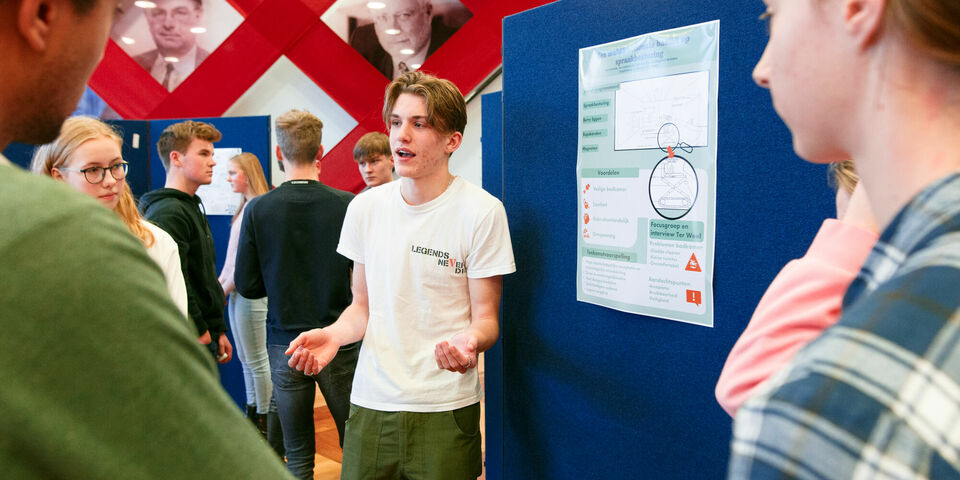Thrombosis pen wins IE&IS's Innovation Challenge
Challenge high schoolers in the last two years of pre-university education to devise a technology that could be part of everyday life in the year 2040, and they'll come up with surprising ideas. Solar panels in space, a way to refresh discarded food, and an injection pen for thrombosis patients all made it to the final pitches, held in a TU/e lecture theater. Earlier, in the Senate Room, the jury heard these and eleven other presentations.
Nick Janssen of Varendonck College in Asten won the competition with his suite of tools for thrombosis patients with a fear of needles: an injection pen and scanners to spot blood vessels (which must be avoided at all costs) and software for storing all kinds of information. Armed with this thrombosis pen, the patient is less dependent on healthcare staff, and so, he believes, this complete set will solve a major societal problem.
Innovation Challenge is an idea that Industrial Engineering & Innovation Sciences came up with as a way to introduce high schoolers to their degree programs in Psychology & Technology, Sustainable Innovation, and Industrial Engineering.
Charlie Rijvers, a master's student of Human Technology Interaction, is a third-time member of the Innovation Challenge committee. She has often been pleasantly surprised by the students' commitment to the task and the questions they ask. This year she supervised three groups and saw the students grow. She got to see how Nick Janssen developed his injection pen for thrombosis patients, “including technical drawings and Augmented Reality app”, and how one group designed a voice-operated bath hoist in order to make the ritual of bathing easier and safer for seniors.
Contact
Over the course of the Innovation Challenge, the high-school students physically come to TU/e on three occasions. Shortly before the summer vacation they come to the launch day to hear the project explained, to take a guided tour of the campus, and to meet potential supervisors. At the end of that day, they get to state their preferred track: Sustainable Innovation, Innovative Entrepreneurship, or Human-Centered Design. “We also offer to put them in touch with professors, student teams or doctoral candidates who can answer questions related to the field they're working in,” says Rijvers.
Presentation
A follow-up day is held in the fall. Here, they can start working up their own ideas, in workshop sessions on presentations and posters. And in January, today, it's the day of the final. “Students present their work to each other and a critical jury. The jury assesses the fourteen groups who are still in the running and choose the three who will go on to make a final presentation."
A group from a technology academy in Castricum is aiming to reduce traffic congestion by making public transport more appealing. The students have devised a shuttle system, and a passenger capsule, printed in 3D, is hanging beside their poster. “We followed tips given in the workshop. Nothing is too garish and the color pallet has been carefully considered and is used repeatedly in each element.” The students are using this project to complete their exam course Research & Design. When asked what they'll do with the first prize if they win, they laugh. “Ha, ha, the 500 euros isn't even enough to cover the three return journeys Castricum-Eindhoven the four of us have all made.”
Solar cell recycling
Four friends in their last year of high school in Wolvega have also travelled a distance to get here. When a solar panel fell from the roof of Jonas Barendregt's home, it prompted him to wonder what would happen to the debris. A nice subject for a profile paper and for this challenge. “In about thirty years' time, this is going to be a massive problem when huge numbers of solar panels start reaching the end of their productive life.” On their poster about the reuse of solar panels within a circular production system, it says that the frames are made of aluminum, glass and ethylene vinyl acetate. “EVA is a kind of glue that's almost indestructible. That's why during recycling, the glass and the solar cells are put through the shredder together. The glass is reclaimed but the silver threads of the solar cells disappear into the waste material that gets used for various things, like road foundations. That's a shame and is something we want to change.”
Space mining
Quirine Roest and Sven de Steur are two of the six students in their penultimate year of high school in Zierikzee. “We're all doing this as an assignment for R&D and we've chosen space mining as our subject. There are lot of metals in space that we could be using on Earth in electronics or tools. We've identified the problems that have been stopping this from happening.” Neither student yet knows where they may go to university. Sven thinks TU/e is a bit too far away and, besides, it's huge. “There are more students here than there are people living in the whole of Zierikzee.”
While the jury is deliberating, the students get together to choose the winner of the audience award. It goes to the team that's working on a plastic-eating fungus.





Discussion